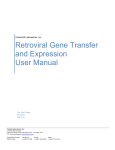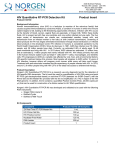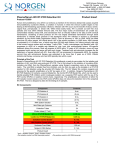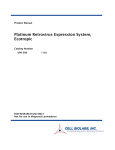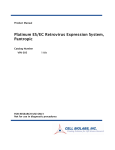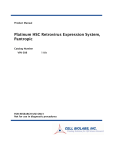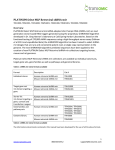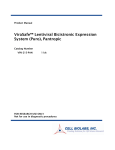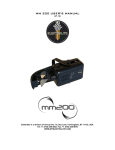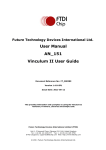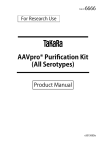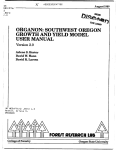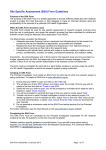Download GLP 000 Laboratory Procedure FORMAT
Transcript
THE UNIVERSITY OF NEWCASTLE- DISCIPLINE OF MEDICAL BIOCHEMISTRY STANDARD OPERATING PROCEDURE Procedure Type: PROCEDURE NO: MOD: Page: GLP 107 1st Issue 1 of 8 General Laboratory Procedure Title: Ping-Pong Retroviral Infection of Phoenix and PT-67 packaging cell lines and subsequent knockdown of hFAT and hScrib genes. 1. Introduction Current retroviral gene transfer technology is based on the coordinated design of packaging cell lines and retroviral expression vectors. The development of packaging lines—cell lines that package recombinant retroviral RNAs into infectious, replication-incompetent particles— created a new level of safety and control (Mann et al., 1983; Miller & Buttimore, 1986). To develop a packaging cell line, the viral gag, pol, and env genes—necessary for particle formation and replication—are stably integrated into the genome of the packaging cell line. The separate introduction and integration of the structural genes minimizes the chances of producing replication-competent virus due to recombination events during cell proliferation (Morgenstern & Land, 1990; Miller & Chen, 1996). Retroviral expression vectors provide the packaging signal Ψ+, transcription and processing elements, and a target gene. Inserts of up to 6.5 kb can be efficiently packaged. Transfection of the retroviral vector into a packaging cell line produces high-titer, replication-incompetent virus. The viral env gene, expressed by the packaging cell line, encodes the envelope protein, which determines the range of infectivity (tropism) of the packaged virus. Viral envelopes are classified according to the receptors used to enter host cells. For example, ecotropic virus can recognize a receptor found on only mouse and rat cells. Amphotropic virus recognizes a receptor found on a broad range of mammalian cell types. Dualtropic virus recognizes two different receptors found on a broad range of mammalian cell types. A pantropic packaging cell line provided a major advancement in retroviral gene transfer, as this cell line produces virus that can infect both mammalian and non-mammalian cells (Burns et al., 1993). Using this cell line, virions are pseudo-typed with the envelope glycoprotein from the vesicular stomatitis virus (VSV-G). Unlike other viral envelope proteins, VSV-G mediates viral entry through lipid binding and plasma membrane fusion (Emi et al., 1991). Stable expression of the VSV-G envelope protein is toxic; thus, the packaging cell line only contains the viral gag and pol genes. Virus is produced by transiently cotransfecting a retroviral expression vector and pVSV-G into a pantropic packaging cell line. Once a packaging cell line is transfected with a retroviral expression vector that contains a packaging signal, the viral genomic transcript containing the target gene and selectable NAME (signed) DATE WRITTEN BY CHECKED BY AUTHORIZED BY Charles de Bock Lynn Herd Phillip Dickson th 12 June 2007 Distributed To: GLP Master File / GLP Lab File th 13 June 2007 13th October 2008 DISCIPLINE OF MEDICAL BIOCHEMISTRY Title: PROCEDURE NO: Page: GLP 107 2 of 8 Ping-Pong Retroviral Infection marker are packaged into infectious virus within 48–72 hrs. Alternatively, you can use antibiotic selection to select cells that stably express the integrated vector. Stable virusproducing cells can be frozen and used in later experiments. Virus produced by both transient and stable transfections can infect target cells and transmit target genes; however, it cannot replicate within target cells because the viral structural genes are absent. 2. Risk Assessment: This Risk Assessment is to be used as a general guide and as such, cannot accommodate all the varying factors that may be encountered when using this procedure. Therefore, personnel are requested to conduct their own Risk Assessment before using this procedure to include any extra hazards introduced by the task performed. TASK PERFORMED Use of a amphotropic Retroviral Expression System for the Infection of Target Cells HAZARDS 1. Viruses containing the VSV-G envelope protein are potentially capable of infecting humans. BIOHAZARD 2. Viruses packaged from MMLV-based vectors described here are capable of infecting human cells BIOHAZARD 3. Working with genetically modified cell lines RISK ASSESSMENT 1. The risk of exposure to viruses containing the VSV-G envelope is minimised by the conditions under which these viruses are produced and the cell-lines into which the viruses are introduced. The risk is considered to be low providing all of the Risk Controls are followed. 2. The risk of working with genetically modified cell-lines is low providing all of the Risk Controls are followed. 3. The risks involved with this work must be re-assessed each time a new cell-line is introduced to ensure that the target cell-line lacks the viral structural and polymerase/integrase genes necessary for viral replication. RISK CONTROL 1. Approval must be obtained from the University of Newcastle Institutional Biosafety Committee and the OGTR before any work involving the use of this procedure may proceed. Changes to the procedure involving the use of different cell-lines or vectors must be approved by the IBC before any further work proceeds. 2. Always practice safe laboratory procedures 3. All work must be performed in a Physical Containment Level 2 Tissue Culture Facility 4. Use a Class II Biosafety cabinet with HEPA filter DISCIPLINE OF MEDICAL BIOCHEMISTRY Title: PROCEDURE NO: Page: GLP 107 3 of 8 Ping-Pong Retroviral Infection 5. Limit access to the areas in which this work is to be performed. All work should take place in the Retroviral Laboratory – LS3.22 6. Use appropriate PPE - double gloves plus a lab coat and safety glasses 7. Use ethanol, detergents, or bleach to inactivate retroviral vectors –eg. Sodium hypochlorite with final volume 1-3% active chlorine, detergents at a specific concentration which you can document as suitable to inactivate the vectors, 70% ethanol. 8. Autoclave all waste not treated with 1-3% sodium hypochlorite for decontamination prior to disposal. 9. Post biohazard warning signs on doors to facility, and on all equipment which will be used during this work. 10. Minimize production of aerosols. Packaging cells and infected cells should not be used outside a biohazard hood until proven that no infectious virus particles are being produced. When pipetting virus-containing supernatants and transferring plates or flasks to and from the biohazard hood, the production of aerosols should be avoided. 11. Take precautions with sharps, in particular needles and dispose of them promptly into a sharps container for autoclaving. 12. Centrifuges fitted with lids on individual buckets must be used. 13. Place packaging and retroviral-infected cells into a separate incubator reserved specifically for this cell work. This incubator may not be used for other cell lines until it has been totally disinfected following the end of the work with viruses containing the VSV-G envelope. 14. All pipettes and plasticware should be disinfected by spraying with 70% ethanol and leaving for 15 minutes prior to removal from the Biosafety cabinet. Alternative disinfection can be achieved by soaking in a sodium hypochlorite solution containing at least 1% active chlorine for 30 minutes. 15. Refer to GEP005 Biohazard Hood for any procedures involving the use of the Biohazard hood. 16. All persons using the Autoclave must have received training in its operation and have read the relevant equipment procedure. 17. Training must be provided by personnel experienced in this procedure or in similar retroviral work. 18. All personnel working with these materials must read and sign the approval from the OGTR / IBC. 19. Training must be undertaken in General Laboratory Safety, Microbiological Safety and Molecular Biology Safety. DISCIPLINE OF MEDICAL BIOCHEMISTRY Title: PROCEDURE NO: Page: GLP 107 4 of 8 Ping-Pong Retroviral Infection I have read and understood the Risk Assessment for GLP 107 - Ping-Pong Retroviral Infection. I agree to abide by the Risk Controls outlined in this Assessment. Name Signature Date DISCIPLINE OF MEDICAL BIOCHEMISTRY Title: PROCEDURE NO: Page: GLP 107 5 of 8 Ping-Pong Retroviral Infection 3. Purpose: 3.1. Infection of hard-to-transfect non-rodent cell lines 3.2. Production of transgenic target cells stably expressing an integrated gene of interest 4. Equipment: 4.1. Class II Biosafety Cabinet with a HEPA microfilter 4.2. Laboratory gown 4.3. Safety glasses 4.4. Disposable gloves – latex, nitrile or vinyl o 4.5. Separate tissue culture incubator – 37 C, 5% CO2 4.6. Eppendorf centrifuge 4.7. Autoclave 5. Materials: 5.1. Low protein-binding 0.45µm filter - Millipore, Billerica, MA, USA 5.2. autoclave bags – double bagging 5.3. 60mm tissue-culture plates 5.4. 45 mm2 filter-capped tissue culture flasks 5.5. 1.5ml microcentrifuge tubes 5.6. 5ml sterile yellow-capped tubes 6. Reagents: 6.1. Lipofectamine 2000 - Invitrogen 11668-019 6.2. Opti-MEM media - Invitrogen 51985-034 6.3. Growth media - usually 4 ml DMEM / 2% FCS without antibiotics 6.4. DMEM/10% FCS containing 8 µg/ml polybrene (Chemicon, Temecula, CA, USA). 6.5. Geneticin (G418) – Invitrogen 10131-027 6.6. PBS 7. Cell-lines / Vectors: 7.1. PT-67 packaging cells, Pheonix Packaging cell line. 7.2. MMLV-based retroviral plasmid containing the gene of interest 7.3. LK-63, Jurkat, JM, MM200, C32 human cell lines. All cell lines are free of the viral components required to produce an infectious viral particle through a recombination event. DISCIPLINE OF MEDICAL BIOCHEMISTRY Title: PROCEDURE NO: Page: GLP 107 6 of 8 Ping-Pong Retroviral Infection 8. Set Up: 8.1. Ensure that you have read and understood the Safety Precautions (Section9 of this SOP) prior to commencing this procedure. 9. Safety Precautions: 9.1. Good laboratory techniques are to be used at all times. 9.2. Autoclave for decontamination 9.3. Use un-recirculated exhaust air. All work to be carried out in isolated PC3 laboratory equipped with separate air supply. 9.4. Stock chemical disinfectants for spills (see 9.6) 9.5. Use a separate tissue culture incubator which is reserved specifically for this work only. 9.6. Susceptible to 1% sodium hypochlorite, 1% SDS, 70% ethanol. Recommend fresh solution of 10% bleach for 30 minutes to overnight. 9.7. Viral particles are extremely labile and do not survive on environmental surfaces. 9.8. First Aid/Treatment: For splashes to the eye of material containing virus, rinse eye at eyewash for 15 minutes. In the case of accidental injection of material containing virus, wash area well with soap and water then contact office of Occupational Health and request serum sample. 9.9. Spills: Evacuate area, turn of air-conditioning and allow aerosols to settle for 30 minutes; assemble a team of three persons, one to act as observer; wear protective clothing and gently cover the spill with adsorbent paper towel and apply freshly prepared 10% sodium hypochlorite starting at the perimeter and working towards the centre; allow at least 15 minutes contact time before clean up. 9.10. Do not remove hands from hood without discarding ‘infectious’ gloves and replacing with clean gloves 9.11. Always dispose of lab gown when finished work - do not walk around laboratory in gown used for retroviral work. 9.12. Lab gown should be placed in separate double autoclave bag and autoclaved prior to washing. 9.13. All solid waste should be discarded into an autoclave bag situated inside the biohazard hood. The bag should be sealed, and sprayed with 70% ethanol before removal from the hood and placement into a 2nd autoclave bag outside of the hood. 9.14. Always autoclave retroviral waste ASAP. Do not rely on UV in hoods 9.15. Any material that has been in contact with retrovirals must be treated as infectious. DISCIPLINE OF MEDICAL BIOCHEMISTRY Title: 10. PROCEDURE NO: Page: GLP 107 7 of 8 Ping-Pong Retroviral Infection Method: Retroviral Production using Ping-Pong method. 10.1. Plate Phoenix cell line at 1 × 106 cells per 100-mm tissue culture plate in growth medium (usually 10 ml DMEM/5% FCS) 24 hours before the transfection and incubate at 37°C until needed. This should achieve a cell density of between 60-80% the following day. 10.2. After 24 hours, 1 ug of pSIREN or pSUPER plasmid DNA containing shRNA sequence to hFAT or hScrib are transfected into the Phoenix Cell line using FuGene transfection kit (Roche) according to manufacturer’s instructions. 10.3. 48 hours post infection, the viral-containing supernatant was carefully collected with a disposable Pasteur pipette and filtered through a 0.45µm filter to remove particulate matter (Millipore, Billerica, MA, USA), and used for cell infection of the PT-67 cell line. 10.4. The supernatant from the Phoenix cell line is plated on to PT67 cells in the presence of 8 ug/mL Polybrene and left for 24 hours. The media is then changed (DMEM/5% FCS ) and left for a further 48 hours. This will establish stable infected cell lines for long term propagation. The supernatant from the PT-67 cell line contains dual tropic retrovirus capable of infecting both mouse and human cell lines. This is a stable infected cell line. 10.5. If necessary (if infection frequency is low), a pure population of zs-Green cells (encoded by the pSIREN plasmid) will be sorted using FACS, or selected for using Puromycin (encoded by the pSUPER plasmid). Infection of Cells with Viral Supernatant 10.6. 24 hrs prior to infection, Adherent cell lines will be plated out into 6-well plates. Cells are grown in 45 mm2 filter-capped tissue culture flasks. On the day of infection, the media is replaced with 2 ml of a viral supernatant from PT-67 cells supplemented with 8 µg/ml polybrene. 10.7. Suspension cells are centrifuged at 1000 rpm for 5 minutes in centrifuge and resuspended 5 ml viral supernatant from PT-67 cells supplemented with 8 µg/ml polybrene and placed into a T25 tissue culture flask. 10.8. Cells are incubated for 24 hours and the viral supernatant replaced with fresh culture medium and allowed to expand for 4 – 6 days. 10.9. Cells will then be lysed and assayed for knockdown of FAT or Scrib protein using Western blot analysis. If knockdown is insufficient, stable knockdown cell lines will be sorted using FACS for zsGreen (encoded by pSIREN vector) or with puromycin (encoded by pSUPER vector). 11. Maintenance: 11.1. Equipment (i.e. biohazard hoods, incubators, centrifuges and pipettes) are to be de-contaminated with 70% ethanol or 1% sodium hypochlorite solution after use. Highly contaminated pipettes are to be double-bagged and autoclaved. DISCIPLINE OF MEDICAL BIOCHEMISTRY Title: 12. PROCEDURE NO: Page: GLP 107 8 of 8 Ping-Pong Retroviral Infection Shutdown: 12.1. All solid waste to be double-bagged and placed into a secondary container for transport and autoclaved prior to disposal. Liquid waste is removed into Vacuum Containers to be incubated in 10% bleach solution for at least 30 min prior to disposal into contaminated waste. 13. References: Burns, J. C., Friedmann, T., Driever, W., Burrascano, M. & Yee, J.-K. (1993) Vesicular stomatitis virus G glycoprotein pseudotyped retroviral vectors: concentration to very high titer and efficient gene transfer into mammalian and nonmammalian cells. Proc. Natl. Acad. Sci. USA 90:8033–8037. Emi, N., Friedmann, T. & Yee, J.-K. (1991) Pseudotyped formation of murine leukemia virus with G protein of vesicular stomatitis virus. J. Virol. 65:1202–1207. Mann, R., Mulligan, R. C. & Baltimore, D. (1983) Construction of a retrovirus packaging mutant and its use to produce helper-free defective retrovirus. Cell 33:153–159. Miller, A. D. & Buttimore, C. (1986) Redesign of retrovirus packaging cell lines to avoid recombination leading to helper virus production. Mol. Cell. Biol. 6(8):2895–2902. Miller, A. D. & Chen, F. (1996) Retrovirus packaging cells based on 10A1 murine leukemia virus for production of vectors that use multiple receptors for cell entry. J. Virol. 70(8):5564–5571. Morgenstern, J. P. & Land, H. (1990) Advanced mammalian gene transfer: high titer retroviral vectors with multiple drug selection markers and a complementary helper-free packaging cell line. Nucleic Acids Res. 18:3587–3590. Retroviral Gene Transfer and Expression User Manual-CLontech (PT3132-1) 14. Change History: 14.1. Issue Number: Date Issued: 14.2. Issue Number: Date Issued: Reason for Change: 1st Issue 19th November 2008








